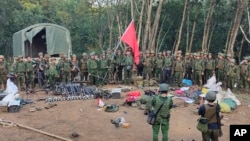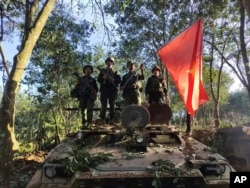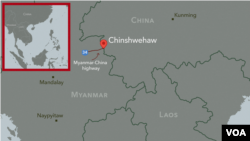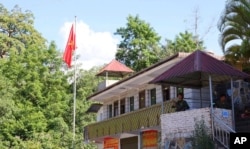It was a stark admission from Myanmar’s military regime, now nearly three years into a nationwide civil war triggered by its February 2021 putsch of the country’s democratically elected government.
On November 1, junta spokesman Zaw Min Tun conceded that rebels had taken full control of Chinshwehaw, a key town on the border with the country’s largest trade partner, China. In a statement, he said it was now empty of all regime officials, police and soldiers.
Chinshwehaw’s fall is part of a new offensive launched October 27 by a trio of ethnic minority-led rebel groups in the north of eastern Myanmar’s Shan state. According to statements by the groups and reports from local media, they have overrun dozens of military posts across the region, seized major roads leading in and out, and forced the surrender of over 100 soldiers.
The so-called Three Brotherhood Alliance — comprising the Myanmar National Democratic Alliance Army, Ta’Ang National Liberation Army and Arakan Army — has dubbed the offensive “Operation 1027,” for the date of its onset.
While a patchwork of armed resistance groups already control or contest at least half the Myanmar countryside, analysts say Operation 1027 stands out for its exceptional planning, execution and coordination, and could have crucial reverberations beyond the immediate area of the offensive.
“1027 is a significant milestone since the coup,” said Matthew Arnold, an independent analyst closely tracking the post-coup fighting.
“The operation has been remarkable in terms of just how systematic they have been targeting strategic places,” he told VOA. “They’ve very deliberately been going road by road, crossroad by crossroad, junction by junction and denying the junta access to the China border.”
Jason Tower, Myanmar program director for the United States Institute of Peace, a U.S. government funded think tank, agreed.
“It has made very rapid progress in just decimating the military on the battlefield along one of the most important crossings in the China-Myanmar Economic Corridor, bringing a significant portion of that territory in just a couple of days' time under the control of the ... alliance,” he said.
'A devastating blow'
That corridor includes parallel oil and gas pipelines cutting across Myanmar from the Bay of Bengal to the China border where the Brotherhood has launched its offensive, plus plans for a highway and railroad. Chinshwehaw itself is the linchpin in an overlapping trade route the two countries opened in late 2021.
With 1027, the Brotherhood has cut the junta off from a stretch of land that was handling some 40% of bilateral border trade, Tower said, “and that is huge.”
The stretch covers only a fraction of the more than 2,000 kilometers of border that run between China and Myanmar. Most of the rest is rugged and remote and ill-equipped to handle heavy traffic, and also controlled or fiercely contested by other rebel groups. That includes the Kachin Independence Army in Kachin State, in Myanmar’s far north.
Combined, rebel groups can now deny the junta virtually all meaningful border access to its largest trade partner, Arnold said, and “in any war that would be a massive milestone.”
By seizing major roads and bridges in the north of Shan, the analysts add, the Brotherhood could make it much harder for the military to send reinforcements not only into Shan but also up to Kachin, or even Sagaing Region in the northwest. Both Kachin and Sagaing have seen some of the heaviest fighting of the civil war.
“We’re ... talking about a devastating blow in terms of the military’s ability to mobilize troops up to the north, so this is going to have implications way beyond just the areas [in Shan] that we’re talking about,” said Tower.
Even beyond the north, they say 1027’s success and the military’s failure thus far to mount a meaningful counter-offensive profoundly puncture the junta’s air of invincibility. They say the offensive could galvanize other rebel groups to mount more ambitious operations of their own and drain the morale of regime forces elsewhere.
“If [Myanmar soldiers] come to the conclusion that the military can’t reinforce Shan, then their conclusion will be, well, they can’t support us, they can’t resupply us, they’re not going to send us any reinforcements. And [then] the only obvious question is, what’s the point? That’s when you start to get the collapse,” Arnold said.
'Towns can be taken'
China is watching closely, too. While maintaining ties with some of the rebel groups, Beijing has backed the junta on the international stage and, along with Moscow, is the military’s main arms supplier.
Since the start of Operation 1027 in northeast Shan, a part of the state also known as Kokang, China has called for a cease-fire in the area and sent its public security minister, Wang Xiaohong, to Myanmar to meet with junta leader Min Aung Hlaing.
The minister’s focus likely fell on the growing number of Chinese cyberscam gangs operating in Myanmar, “but the Kokang conflict [had] to be on his agenda as well,” said Yun Sun, China program director at the Washington-based Stimson Center.
She said Beijing probably expects any disruption of border trade along the China-Myanmar Economic Corridor to be temporary, as they have in the past, and that the junta’s losses in the area will not have shaken China’s overall bet on the regime’s hold on power.
“[I] don't think China will see the 1027 offensive as vital to [the] junta's control of the country. [The Brotherhood’s] objective is limited to the Kokang area only. The military still controls the main cities and Burma areas,” she said, referring Myanmar’s ethnic majority.
In a statement the Brotherhood issued the day it launched the offensive, though, it said its objectives include ousting the junta.
Arnold said 1027 also highlights the mounting pressure rebel groups are putting on urban areas across Myanmar.
The junta still has firm control of Myanmar’s capital, Naypyitaw, and its largest city and commercial hub, Yangon. But beyond that, said Arnold, the military is having to fight closer and closer to towns and cities across the country, and in many towns is effectively confined for its own safety to a few buildings and barracks.
“This is where I think 1027 is so important,” he said. “It’s shown that towns can be taken, even heavily, heavily garrisoned towns.”













